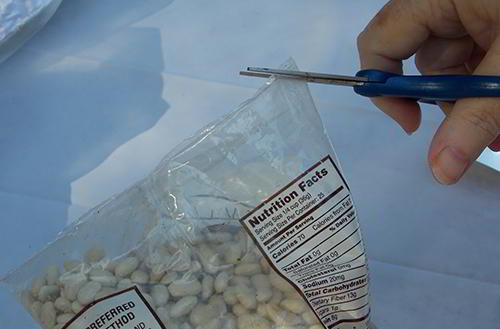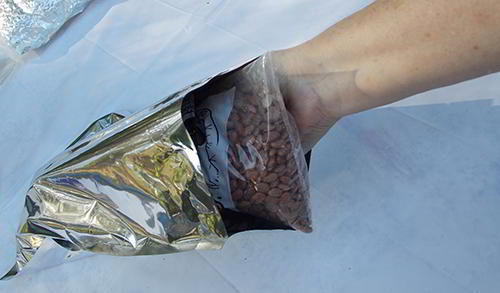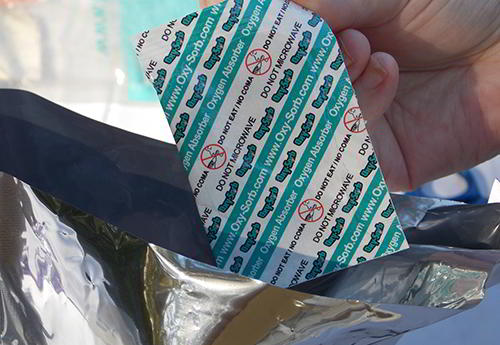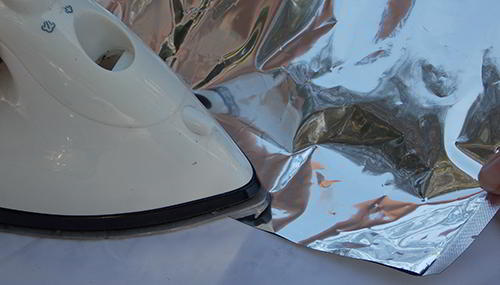Shelf life varies, depending on the storage conditions and the food. You will usually see a range indicated for shelf life. For example, rice is listed as 15-30 years, and some sources estimate 10-15 years. Here are 19 more foods that will last for decades. Usually, this difference in keeping time is an indicator of the food’s nutritional value. For example, after 10 to 15 years the nutrients in rice will begin to break down. The rice is still safe to eat for 30 or more years under the right conditions, but it may have lost most of it’s nutrition.
Dry foods will keep long past their expiration date if they are packed dry and oxygen is excluded from the package. This means repackaging foods in sealed cans or mylar bags and using oxygen absorbers or a vacuum pump to exclude all oxygen. Many people use their foodsaver type vacuum machines to remove the air, sealing the food in a vacuum tight bag, then placing the bags into a larger Mylar bag with oxygen absorbers.
Once vacuum sealed, the food will keep until you have enough to fill your Mylar bag. This is a good method to use when buying small amounts at a time, but packing in Mylar with an oxygen absorber is best. We will discuss the sealing process later.
When sealing food in large Mylar bags, such as the 3-6 gallon sizes, place the bag in a bucket or other appropriate food safe container before filling. The bag will need the support of the sides for filling and storing.
How To Use Oxygen Absorbers The Right Way
Oxygen absorbers can be used with Mylar bags, glass jars with a sealing gasket on the lid, and PETE plastic bottles with gasket type lids. The container must seal completely for the oxygen absorbers to do their job.
Oxygen absorbers are better at removing oxygen than most vacuum devices, but may not provide the visual proof that many people expect. This is because air is only 20% oxygen, so the nitrogen and other components remain after the oxygen is absorbed. Many times you will see the Mylar bag contract around the food after a few hours, but do not be alarmed if it doesn’t. As long as the container is sealed, the oxygen absorbers will do their job.
Wait to open the oxygen absorber package until the food is packed and you are ready to seal it. After opening, remove the number that you will use within the next 30 minutes, then seal the remaining oxygen absorbers in a glass jar or a vacuum sealed bag. DO NOT OPEN the individual foil packed absorber!
Packing Dry Foods In Mylar Bags With Oxygen Absorbers
Follow these steps to safely pack dry foods:
- Pack foods well within their useful life, before their expiration date. Make sure they are completely dry.
- Choose the size of Mylar storage bag you will use. If you are using bags larger than 1 gallon, place them in a bucket for support.
- Clip a tiny corner or slit into the food packaging, or remove it. This allows oxygen to be pulled from inside the packaging.

- Place the food in the bag. Do not overfill. Leave room for sealing.

- Check the inside lip of the bag for small food particles that can interfere with the seal. Clean the inside of the bag with a dry cloth, if needed.
- Add oxygen absorbers on the top of the food in the Mylar bag. DO NOT OPEN the individual foil packed absorber, the contents are not edible.

- Seal the Mylar with an impulse sealer for best results. If you are using an iron, check the seal thoroughly to be sure it is completely sealed. Label the bags with the contents, date sealed and a use by date.

- If using buckets, seal the bucket with a lid and gasket. Store the sealed bags or buckets in a cool, dark and dry place. Place them off the floor, elevated on a shelf to allow air circulation around and under the buckets or bags.
- Rotate foods, using within their storage shelf life.
Suitable Foods for Drying and Long Term Storage
Almost every food can be stored under the right conditions. Meats and vegetables can be canned, dried, freeze dried, pickled, or cured. Here are 10 long shelf-life canned foods every prepper should consider stockpiling.
Here is a list of foods suitable for dry storage, along with how long they will keep sealed in Mylar with oxygen absorbers and stored under good conditions:
- Whole hard grains such as Buckwheat, Dry Corn, Kamut, Hard Red Wheat, Soft White Wheat, Millet, Durum wheat, and Spelt keep for 10 years or more.
- Soft grains such as oats, barley, quinoa, and rye. Stored whole, these grains will last 8 years or more.
- White Rice keeps for 10 – 30 years stored under proper conditions. Use brown rice within 2-5 years. Brown rice contains oils which can go rancid.
- Corn keeps for up to 30 years or longer when stored whole. Cornmeal is good for 5 to 10 years
- Dried potato slices, dices and flakes keep for up to 30 years, but may yellow a bit over time.
- Professionally dehydrated vegetables keep for 10 to 20 years, and freeze dried fruits and vegetables for up to 25 years. Use home dehydrated foods within 2 to 5 years. Moist fruits such as raisins are not suitable for sealing.
- Sugar keeps indefinitely without an oxygen absorber or vacuum. Keep it dry, however or you’ll have a hard lump.
- Pasta keeps for 20 to 30 years.
- Powdered milk keeps for up to 20 years
- Dried beans such as pinto beans, kidney beans, lentils, black eye peas, lima beans, and other dried beans keep for 10 to 30 years or more. Beans keep well, but require longer to cook as they age. Older dried beans cook well in a pressure cooker.
- Flour, cornmeal, and baking mixes, 5 to 10 years
Related: 50 Days of ‘Survival’ Calories with Rice and Beans
How Many Oxygen Absorbers To Use? What Size?
Oxygen absorbers come in different sizes, indicated by the number of CC’s of oxygen that they will absorb. Once again size recommendations come in ranges, because some foods have more spaces around them to contain oxygen. Densely packed rice will harbor less oxygen than pasta that packs loosely and has holes running through it. Use the recommended cc’s for your bag size, adding the maximum for porous and loosely packed foods.
For 1 to 2 quart glass jars and mylar bags, use 100 to 300 cc’s, depending on the food density. Gallon containers need 300 to 500 cc’s. For 5 to 6 gallon buckets, lined with Mylar, use 1500 to 2000 cc’s.
If the recommendation is for 1000 cc’s of oxygen absorbers, you can use one 1000 cc absorber, two 500 cc absorbers, four 300 cc absorbers or any combination that adds up to 1000 or more. Notice that when using 300 cc absorbers, three would only give you 900 cc, so you need to add a fourth, even though you go over the minimum recommended amount.
Related: 10 Foods Not to Store
So What Are The Right Conditions? Storage Life Depends On Four Variables:
- Temperature: Heat is your enemy. Foods break down faster at higher temperatures. Store your long-term food products below 75°F/24°C whenever possible. If you must store foods at higher temperatures, rotate them more often to ensure nutritional quality.
- Moisture: Foods must be completely dry before packing and don’t package them on extremely humid or rainy days. If moisture levels exceed 10% inside the air-tight packaging, foods can spoil.
- Light: Mylar bags do an excellent job of keeping out light, but foods stored in clear PETE bottles or glass jars need to be stored in a dark room or cupboard.
- Insects and Rodents: Freezing products for a day or two then allowing them to warm again before sealing kills insects and eggs that may be present. Whenever possible, store sealed packages in rodent proof containers such as food safe metal cans. Empty popcorn tins do a good job of excluding rodents. Watch your storage areas for signs of rodent droppings and act quickly if you suspect an infestation.
Related: 10 Food Lessons from the Great Depression
Signs of Spoilage
Always check foods for signs of spoilage before and after opening. Before opening, look for bloated bags or cans. If a Mylar bag has blown up like a balloon, discard it without opening. This can be caused by too much moisture in the food before sealing.
After opening, look for signs of mold or spoilage of any kind. Some foods, such as rice, dried potatoes and grains can yellow slightly over time and are still safe to eat. Dramatic changes in color may indicate spoilage. Also give food the sniff test. An off odor is also an indication of spoilage.
One of the most important rules of long term food storage is to know the shelf life of your foods and rotate them so that you always have a fresh supply. This doesn’t mean that you should waste food, but rather rotate your oldest food stores into current use and package new purchases for long term storage.
You may also like:
What is Your Favorite Food to Stockpile?
DIY Device That Turns Air Into Fresh Water! (video)
How To Make a Mini Root Cellar In Your Backyard In Less Than Two Hours















Food containers stored in sealed cardboard boxes will also exclude light. I reinforce my boxes by adding cardboard on the inside to make the containers inside fit snugly and gluing brown paper on the outside. It make a rigid box that is light weight and doesn’t allow light in.
You can buy boxes for 1 quart mason jars from U-line, a packaging supply company. No connection to them financially though I have used them to purchase supplies such as an impulse sealer and plastic.
I used to live in a big old house by a wooded area and had a problem with rodents. By accident, I found what kills off mice. A bag of powdered sugar had it’s bottom chewed through with a dead mouse laying there with it’s nose in the powder.
I like the idea of the boxes as something square is easier to store than round tubs.
Years ago( before the age of convenience) my father-in-law used a flour paste to hang large paper targets for 600 & 1000 yrd shooting range. The flour was stored down range and very susceptible to mice problems, so they would mix plaster of paris with the flour and left some in an easy place for the mice to get. The mouse never came back for seconds…..
Might be an idea for a separated article, Non-Toxic pest controls ?
Survival Food Tabs. It is what NASA used in outer space. No preparing necessary, no water or fire necessary. Also, Barocook flameless cookware. for this you add water to the cookware, throw in the tab, and the tab boils the water. the water stays separate from the food. Both of these can be bought on Amazon. Not attracting attention with scent and smoke is important. These accomplish that. Barocook can be done inside your home. it is important to have many different forms of ways to eat/drink. having a solar oven is excellent too. if you have more money than I do, a clay grill. mylar bags with oxygen tabs are excellent. but the Survival tabs, you can carry one case and live for a year. I don’t think anything can beat that.
Are these tabs low in calories? Is it something recommended to supplement nutrition?
Would you really care about calories when the shtf…I’m sure that I won’t !!!
In an emergency when needing light of a bump of heat. Go to the kitchen and get that unused can of Crisco, make a wick, use something to make hole in center,put wick in and fill hole back up with melted Crisco, Lasts over 100 hrs.
I hope this is not a silly question but after reading the article about sealing the Mylar bags I didn’t understand. If it has to be in the bucket while filling to help support the bag then how do I get an iron on it to seal it?
I never knew this. In the past when preparing the bag I would just gather the top, twist it tight and put cable ties on it to keep it together.
Place the Mylar bag inside the bucket. Home Depot has orange buckets with lids that have rubber sills. These are the best. We like to put beans or rice in the the bottom of the bag before packing other items. After filling the bag, place a 2″x 4″ on top of the bucket. Be sure you left plenty of room to fold and sill the Mylar bag. So that fits completely inside the bucket. After you feel the bag add your O2 pack, lay the bag over the board, NOW this was mentioned, take a vaccum cleaner and suck as much air out as possible, then iron to sill. You may need to fill 5 buckets more or less first before opening your O2 packs. You only have about 30 minutes to use the O2 packs and sill the bags. You can also YouTube this. GOOD LUCK.
Oh yea!
If you just folded the bags, and they are very old, say1-2 years. Then reopen them add O2 packs and sill.
One other thing, make sure you have about 1.5″
Or more from the top of the bucket, add more beans or rice to fill the spaces between the other item. One bucket will hold about 8 days of food for 4 people. Don’t forget to add a pack of coffee, cool-aide, tang, etc. this kind of storage is great for any kind of dry goods. Don’t forget pancake mix. And differently, don’t forget your imagination. That is the only thing that limit your success.
GOOD LUCK.
The word is seal not sill. A sill is the base of a window.
There’s always a fanatic in the mix !!! ?
You can’t learn if you aren’t told when you have an error.
I use my flat iron to seal all my bags. Makes it so much easier, and no it doesnt ruin the flat iron.
cardboard equals roaches from my experience. We get rid of cardboard a.s.a.p. at our house.
I live on the Gulf Coast and have no basement. I have no ready means to store prepper foods in a cool dry place. Any suggestions would be appreciated.
I live in Southeast Georgia. No basement very hot & humid, but I do have area at one end of the house that is cooler than the rest. That’s where I store my preps.
No, Wannabe, they are emergency rations sort of like S.O.S. bars except they are much smaller, don’t have the caloric content of an S.O.S. bar but are more convenient to carry as they come in a bottle, My recollection is you have to cram down 20 of them a day as they are only 100 calories each. They are supposed to be balanced and contain all the necessary vitamins and minerals we need. Sort like a One-A-Day vitamin with calories.
If you store your foodstuff in styrofoam ice chests, it will even out the inside temperature of the food. It won’t get as hot inside the ice chest during the summer and if stored in an unheated room, won’t get as cold in the winter. Don’t be misled by the fact that ice melts fairly rapidly in cheap styrofoam ice chests. Ice starts to melt at 33°F. Your food can be stored very nicely at 70°F. There is a 37° difference be those two figures. I wrap my S.O.S. bars I keep in the trunk of my car in about one inch to 1 1/2 inches of newspaper on all four sides and seal it with heavy stick masking tape. Those bars were still good long after the supposed expiration date.
You should have one or more rooms on the north side of your house that stay cooler than the other rooms, especially if you keep the door and windows closed and the drapes drawn or block the window with cardboard with aluminum foil facing the outside. Cover the stacked food in the styrofoam ice chests with sleeping bags or your winter blankets. They insulate from the heat as well as from the cold.
I tried using oxy absorbers when I sealed up some powdered milk and it turned hard as a rock. I think that the heat the absorbers give off when they are working carmelizes the sugars in the milk? Anyway, now I just store it with desiccants to stop water and try to get as much air out as I can before I close up the container.
I recently opened a mylar bag with oxygen absorber of shredded wheat cereal that have powdered sugar on them, (Spooners). I sealed bag up 11 years ago, there were no signs of bag puncture and cereal looks normal and remains crunchy as it should, but there is a weird smell almost like a chemical odor, it taste fine any ideas on what the odor is? It doesn’t smell rancid and I haven’t become sick after eating one an hour ago 🙂 thanks for any insights
I have 5 gallons of rice in mylar bags with the proper oxygen absorber. It’s been there for 6 years. Once I open it, can I transfer what we don’t consume into 1 gallon mylar bags and re seal with new oxygen absorbers. In other words can I open and then reseal. I hate to lose all 5 gallons worth of rice.
Awesome Video ! Can you put stuffing mix or dry macaroni and dry cheese package that comes with it in mylar bags for long term storage ?
Can store bought jerkey be repackaged in mylar bags with oxygen absorbers? If so, what is the shelf life?
From my understanding you can’t use oxygen absorbers with items that have certain oils in it. So no to flours and meats.
It’s not that you can’t use oxygen absorbers with certain oils in them. Food groups like brown rice for example won’t last as long because of the oils but It will certainly add shelflife to the food item. White rice obviously will last 20 to 25 years because it doesn’t have the oil but there’s nothing to say you cannot use oxygen absorbers with brown rice. Meat will not last long unless it’s canned or freeze dried. once freeze dry then you add the oxygen absorber but raw meat cannot be kept long.
If you keep brown rice, be sure to put in freezer for at least three days. I didn’t and had Indian meal moths flying around my house. Took me awhile to figure out where they were coming from. Rice bags full of webs and caterpillars that eat through the plastic bag.
Ok, I’m new. Can I Leave the bag of rice in it’s bag it came in and put it into the mylar bag with the oxygen or moisture absorber?
THE NEW WORLD ORDER
WEF
WHO
CFR
WE ARE WATCHING YOU
YOU HAVE NO FREEDOM
GET READY FOR THE SENSORSHIP AND DECEPTION
NOW BEGINS , COMPLY OR ELSE
YOU WILL OWN NOTHING AND BE HAPPY
PAY ATTENTION